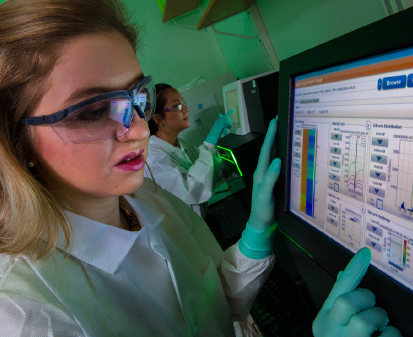NCEZID 2017: Sharing Lab Expertise
Smallpox: New test to provide better results in less time
Before it was declared eradicated in 1980, smallpox was a dangerous infectious disease, and it continues to be a serious threat today. It is now theoretically possible that variola virus, which causes smallpox, could be recreated in a lab and used for a bioterror attack. Therefore, it is important that we have tools ready to protect people should the disease reemerge. In 2017, CDC received US Food and Drug Administration (FDA) clearance for a diagnostic test to detect variola virus. The new test was designed to provide reliable results in less time and will replace the smallpox test previously sent to laboratories through CDC’s Laboratory Response Network. Even though the risk of a bioterror event involving smallpox is believed to be low, the new test could sound an early alarm in the event of such an attack.


MicrobeNet: CDC holds first international bacterial identification workshop
In 2017, CDC held its first international training for MicrobeNet, an online database that can help laboratory scientists identify more than 2,400 bacteria and fungi. CDC MicrobeNet experts partnered with India’s National Centre for Disease Control and biotechnology product manufacturer Thermo Fisher to train Indian scientists on bacterial identification, using DNA sequencing and MicrobeNet. Twenty-four scientists from a variety of organizations attended the workshop in New Delhi. MicrobeNet is used by more than 1,500 scientists from 838 worldwide organizations, which range from state public health labs to international clinical diagnostic laboratories. Pathogens were identified 12,921 times using MicrobeNet in 2017.
AR Isolate Bank: Growing number of experts use CDC’s collection
CDC has amassed a collection of 450,000 antibiotic-resistant isolates.
As antibiotic resistance continues to be among the most concerning challenges to our country’s health, a growing number of microbiologists, drug and diagnostic manufacturers, and researchers are using CDC’s collections of resistant organisms—called isolates—to validate diagnostics in their labs. The CDC and FDA Antibiotic Resistance Isolate Bank provides a unique solution for experts who are looking for the latest samples of drug-resistant organisms. CDC experts gather isolates through outbreak responses and surveillance activities, and they have amassed a collection of 450,000 isolates. This collection is used to create curated panels for distribution to researchers. More than 570 customers have used the isolate bank since its launch in July 2015, and a 2017 survey showed that nearly 70 percent of customers use isolates to validate